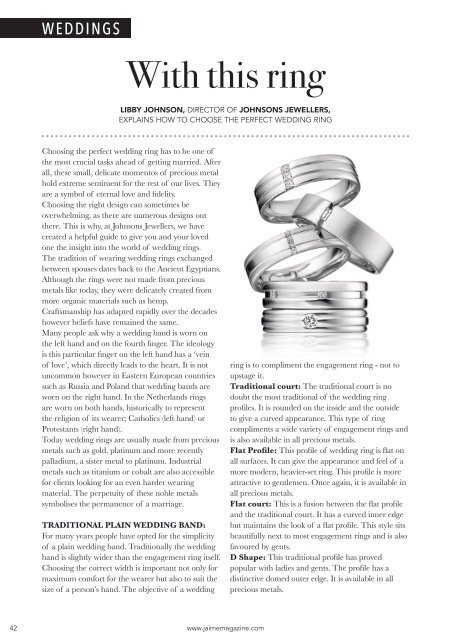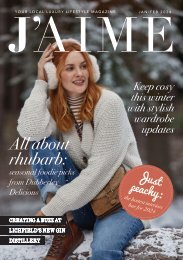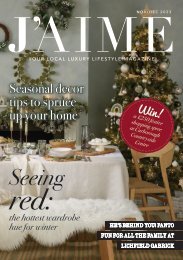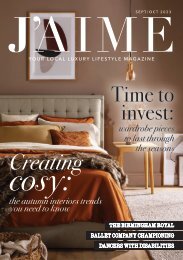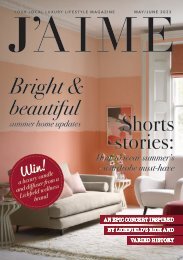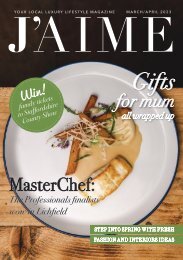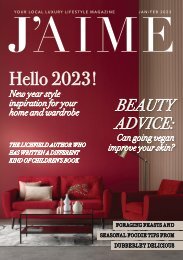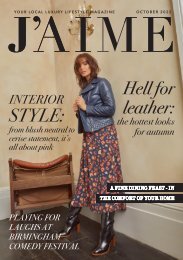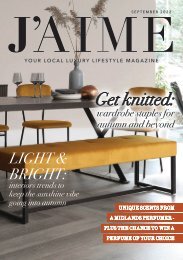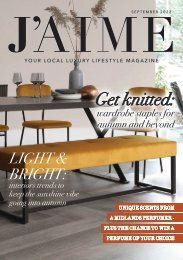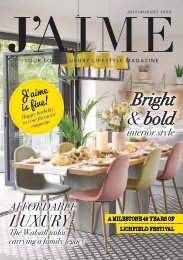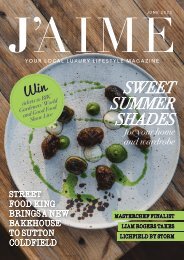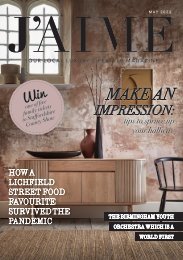J'AIME June 2021
Your local luxury lifestyle magazine
Your local luxury lifestyle magazine
Create successful ePaper yourself
Turn your PDF publications into a flip-book with our unique Google optimized e-Paper software.
W E D D I N G S<br />
With this ring<br />
LIBBY JOHNSON, DIRECTOR OF JOHNSONS JEWELLERS,<br />
EXPLAINS HOW TO CHOOSE THE PERFECT WEDDING RING<br />
Choosing the perfect wedding ring has to be one of<br />
the most crucial tasks ahead of getting married. After<br />
all, these small, delicate momentos of precious metal<br />
hold extreme sentiment for the rest of our lives. They<br />
are a symbol of eternal love and fidelity.<br />
Choosing the right design can sometimes be<br />
overwhelming, as there are numerous designs out<br />
there. This is why, at Johnsons Jewellers, we have<br />
created a helpful guide to give you and your loved<br />
one the insight into the world of wedding rings.<br />
The tradition of wearing wedding rings exchanged<br />
between spouses dates back to the Ancient Egyptians.<br />
Although the rings were not made from precious<br />
metals like today, they were delicately created from<br />
more organic materials such as hemp.<br />
Craftsmanship has adapted rapidly over the decades<br />
however beliefs have remained the same.<br />
Many people ask why a wedding band is worn on<br />
the left hand and on the fourth finger. The ideology<br />
is this particular finger on the left hand has a ‘vein<br />
of love’, which directly leads to the heart. It is not<br />
uncommon however in Eastern European countries<br />
such as Russia and Poland that wedding bands are<br />
worn on the right hand. In the Netherlands rings<br />
are worn on both hands, historically to represent<br />
the religion of its wearer; Catholics (left hand) or<br />
Protestants (right hand).<br />
Today wedding rings are usually made from precious<br />
metals such as gold, platinum and more recently<br />
palladium, a sister metal to platinum. Industrial<br />
metals such as titanium or cobalt are also accessible<br />
for clients looking for an even harder wearing<br />
material. The perpetuity of these noble metals<br />
symbolises the permanence of a marriage.<br />
TRADITIONAL PLAIN WEDDING BAND:<br />
For many years people have opted for the simplicity<br />
of a plain wedding band. Traditionally the wedding<br />
band is slightly wider than the engagement ring itself.<br />
Choosing the correct width is important not only for<br />
maximum comfort for the wearer but also to suit the<br />
size of a person’s hand. The objective of a wedding<br />
ring is to compliment the engagement ring - not to<br />
upstage it.<br />
Traditional court: The traditional court is no<br />
doubt the most traditional of the wedding ring<br />
profiles. It is rounded on the inside and the outside<br />
to give a curved appearance. This type of ring<br />
compliments a wide variety of engagement rings and<br />
is also available in all precious metals.<br />
Flat Profile: This profile of wedding ring is flat on<br />
all surfaces. It can give the appearance and feel of a<br />
more modern, heavier-set ring. This profile is more<br />
attractive to gentlemen. Once again, it is available in<br />
all precious metals.<br />
Flat court: This is a fusion between the flat profile<br />
and the traditional court. It has a curved inner edge<br />
but maintains the look of a flat profile. This style sits<br />
beautifully next to most engagement rings and is also<br />
favoured by gents.<br />
D Shape: This traditional profile has proved<br />
popular with ladies and gents. The profile has a<br />
distinctive domed outer edge. It is available in all<br />
precious metals.<br />
42 www.jaimemagazine.com


